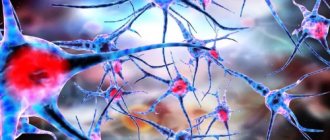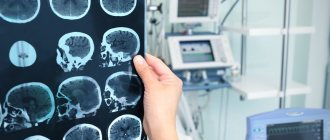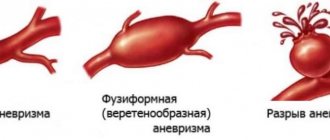Expanding, dull headaches are among the so-called “general cerebral symptoms” that occur in people with brain tumors of various types and locations. They bother approximately 50% of patients, that is, they are among the most common symptoms.
Not all patients experience headaches due to a brain tumor because there are no pain receptors in the gray and white matter. That is, the brain itself cannot hurt. And if the neoplasm is small, non-aggressive and located deep in the accumulation of nerve cell bodies or conducting fibers, then the person does not experience pain for a long time.
When intracranial pressure increases, fluid accumulating in the ventricles of the brain leads to dull, arching pain.
Painful sensations appear when the growing node and the fluid that is formed as a result of the vital activity of tumor cells and accumulates in tissues and cavities begin to compress the cranial nerves, the walls of blood vessels and the meninges - that is, those structures in which there are pain receptors. At the same time, due to an increase in the amount of fluid in a person, intracranial pressure increases, which may be evidenced by certain changes in the fundus of the eye.
What are the symptoms of a brain tumor in the early stages?
All symptoms of a brain tumor in adults are divided into general and focal. General cerebral diseases develop as a result of impaired outflow of cerebrospinal fluid, displacement of the brain, swelling or compression by a tumor mass. Focal ones are caused by the destruction of certain areas of the central nervous system responsible for certain functions.
There are usually no symptoms in the early stages of a brain tumor. The neoplasm can only be detected by instrumental methods. Subsequently, the first signs of a brain tumor are usually focal. What they will be depends on the location of the cancer. Signs of damage to various structures of the central nervous system are described below. Secondary syndromes appear later, when the tumors reach large sizes.
Sometimes with a brain tumor, the first signs are general cerebral. This could be a headache, intoxication, impaired consciousness, etc. But such cases are rare. For example, if the neoplasm is initially located in the third ventricle and quickly blocks the outflow of cerebrospinal fluid, which results in intracranial hypertension.
Forecasts
Brain cancer is characterized by cautious predictions by doctors. A positive outcome depends on the nature of the tumor, its location, size and ability to provoke the spread of metastases.
The easiest way to treat small tumors in a place accessible for surgical intervention, benign in nature and not metastasizing to other organs. Usually one course of radiation or chemotherapy is enough to rid a person of pathology.
However, most benign tumors tend to recur. In this case, repeated surgery will be required, which can lead to serious damage to the nervous system.
Malignant tumors develop rapidly and contribute to the spread of metastases. As a rule, the location is inconvenient for surgical intervention. Removing a brain tumor is impractical or even dangerous. In this case, the prognosis is in most cases unfavorable.
The age and general health of the patient are of great importance. In elderly citizens with severe concomitant pathologies, removal of the tumor through surgery is not available.
How does a headache with a brain tumor hurt?
Not always, but in most cases, headaches are observed with a brain tumor. The symptom occurs as a general cerebral one, less often as a focal one. It can be focal if the tumor grows into the dura mater, which is rich in nerve endings, and the sensitive roots of the cranial nerves. In other cases, headache with a brain tumor appears as a general cerebral symptom.
We must understand that there are no nerve endings in the brain tissue itself. Therefore, this organ cannot get sick. That is, the tumor mass itself does not wrap around the nerves and does not provoke pain, except for the cases indicated above.
In other patients, pain may be associated with the following factors:
- Increased intracranial pressure
- Accumulation of fluid (CSF) in the ventricles
- Spasm or compression of blood vessels
- General intoxication syndrome (like the flu)
Headaches due to a brain tumor that are associated with increased intracranial pressure are called hypertension. It is characterized by a feeling of fullness. Patients complain that they feel pressure coming from inside the skull. Usually the pain syndrome covers the entire head. Sometimes the pain can be more pronounced in the temples, back of the head or forehead. The pain syndrome is often accompanied by nausea and vomiting. It increases in the morning, but may decrease and even disappear completely in the evening.
Headaches caused by the accumulation of cerebrospinal fluid in the ventricular system of the brain are called hydrocephalic. They are characterized by dependence on the position of the head. The patient can take a forced position of the body, in which the pain will be least pronounced. They are often episodic, paroxysmal in nature at the onset of the disease. Then they gradually intensify and become permanent. In the later stages of the pathology, the pain syndrome may weaken.
Vascular headache develops due to a decrease in the lumen of the blood vessels that supply the membranes of the brain. This happens due to their compression by the tumor mass or is the result of spasm (contraction of the smooth muscle structures of the artery walls). The spasm occurs reflexively, as a result of irritation of sympathetic nerve fibers, as well as stretching of the ventricles of the brain.
To a certain extent, the nature of the pain syndrome may depend on the location of the tumor. Thus, supratentorial tumors can be accompanied not only by diffuse, but also localized pain in one temple. When the tumor is located in the parietal lobe, pain occurs sporadically. Occipital lobe cancer can cause migraine-like pain.
Follow-up and control
Treatment for people diagnosed with cancer does not end when active therapy is completed. Your doctor will continue to check to see if the cancer has returned, monitor any side effects, and monitor your overall health. This is called follow-up. It consists of regular medical examinations and tests.
Relapse control
One of the goals of follow-up is to monitor relapse, that is, the reoccurrence of the disease. Cancer recurs because small clusters of malignant cells may remain in the body. Over time, these cells may increase in size until they appear on test results or cause symptoms. During follow-up, your doctor may provide you with personalized information about your risk of recurrence. Your doctor will ask specific questions about your health. You may need to have blood tests or imaging tests as part of your regular follow-up. Follow-up recommendations depend on several factors, including the type and stage of head and neck cancer initially diagnosed and the treatment received. The doctor will also tell you what signs and symptoms to monitor.
Monitoring long-term and delayed side effects
Treatment of malignant tumors is accompanied by various side effects. Long-term effects persist after a period of therapy. Delayed side effects may take months or even years to develop. Long-term and delayed effects may include physical and emotional changes.
Discuss with your doctor the risk of these side effects depending on the type of cancer, your individual treatment plan, and your overall health. If your treatment is known to have some delayed effects, you may need to undergo certain additional tests. For example, if you received radiation therapy, your doctor will recommend that you have regular blood tests to check your thyroid function. Your doctor may refer you to a specialist to treat delayed effects.
Rehabilitation is a major part of follow-up after treatment for head and neck cancer. Patients may receive physical therapy to maintain motor function and range of motion, as well as speech and swallowing therapy to regain skills such as speaking and eating. Proper assessment and treatment can often prevent long-term speech and swallowing problems. Some patients may need to learn new ways of eating or different ways of preparing food.
Patients may look different, feel tired, and be unable to speak or eat as well as before. Many people experience depression. Support groups help patients cope with changes after treatment.
Maintaining your own medical records
You and your doctor will work together to develop a personalized follow-up plan. Be sure to discuss any concerns you have about your own future physical or emotional health.
How does a headache occur with a tumor of the pituitary gland of the brain?
Patients often ask how headaches occur with a tumor of the pituitary gland of the brain. This depends on the stage of the pathological process, the size of the neoplasm, as well as the nature of its growth.
With pituitary cancer, signs of a brain tumor usually do not appear at an early stage. A tumor can become an incidental finding during various types of examinations. If the first symptoms of a brain tumor appear, they are associated with endocrine disorders. After all, the pituitary gland is a gland. It produces hormones. The first symptoms of a brain tumor that occur depend on which hormone production increases.
But with further growth of the tumor and the pituitary adenoma reaching a large size, a headache occurs. It may be different. When the tumor spreads beyond the sella turcica (the anatomical cavity in which the pituitary gland is located), visual impairment appears. And with further growth of the adenoma, the third ventricle may be compressed. As a result, pain sensations characteristic of hypertension syndrome occur.
The neoplasm may grow invasively. Therefore, sometimes it grows into the cavernous sinus. In this case, a diffuse headache of a pulsating nature is observed. Patients often indicate the eyes as the main location.
Select a clinic and treatment
Stages
Staging is a determination of where the cancer is located, whether and where it has spread, and its effect on other parts of the body.
Doctors use diagnostic tests to determine the stage of cancer; they may need information based on tissue samples obtained at surgery, so staging may continue until all tests are completed. Information about the stage helps the doctor determine which treatment is optimal and predict the possibility of recovery.
TNM tumor classification system
One way to determine the stage of cancer is the TNM system. Doctors use the results of diagnostic tests and scans to answer questions such as:
- Tumor (T): its size and location?
- Lymph nodes (N): extent of spread of the process to the lymph nodes?
- Metastasis (M): Has the cancer spread to other parts of the body?
The results are combined to determine each patient's cancer stage. Stage provides a common way to describe cancer so doctors can work together to plan the best treatment.
Focal symptoms of brain tumors
With a brain tumor, symptoms primarily depend on the location of the tumor and the nature of its growth. They are caused mainly by mechanical compression of surrounding tissues. The symptoms depend to a lesser extent on the histological type of the brain tumor. The degree of malignancy of the neoplasm largely determines the timing of the appearance of these clinical signs and their severity. But the symptoms themselves will be the same when the same brain structures are compressed by both benign and malignant formations.
Let's talk about what symptoms a tumor in the brain causes, depending on its location.
Central gyrus
If a brain tumor appears in the central gyrus, symptoms usually include sensory and motor disturbances. New growths of its anterior part are characterized by paralysis and paresis. They are spastic in nature. If the posterior part of the central gyrus is damaged, sensitivity disorders occur.
Based on the symptoms a brain tumor produces, one can approximately guess the location of the tumor. Because the lower part of the central gyrus is responsible for the innervation of the head, the middle part - the arms, and in the area near the interhemispheric fissure - the legs. As the tumor grows, more and more tissues are involved in the pathological process. It is possible to develop motor aphasia - speech impairment due to deterioration of muscle function.
Frontal lobe
With a brain tumor, symptoms may appear late. This often occurs when the tumor is localized in the frontal lobe. The first signs of a brain tumor in the frontal lobe are epileptic seizures. Over time, speech disorders develop due to deterioration in muscle mobility. Smell disturbances often occur. A person may not smell at all.
Often, symptoms of a brain tumor when the tumor is localized in the frontal lobe include mental disorders. They usually develop in the later stages of pathology. A person becomes stupid and cannot motivate his actions. Sometimes he can be aggressive, in other cases, on the contrary, apathetic.
For frontal lobe lesions due to brain tumors, symptoms are often associated with swelling of brain tissue and intracranial hypertension. These disorders appear earlier and are more severe.
Parietal lobe
The main symptoms of a brain tumor localized in the parietal lobe:
- Astereognosis - inability to recognize objects by touch
- Inability to perceive the diagram of one’s own body (a person does not know where different parts of his body are located)
- Disorders of higher functions of the cerebral cortex (writing, reading, counting)
- Apraxia is the inability to carry out purposeful movements while maintaining mobility in general.
- Sensitive skin disorders
- Amnestic aphasia - a person does not remember the names of objects, although he recognizes them and understands what they are intended for (when the tumor is localized on the border with the temporal lobe)
With a brain tumor, symptoms appear later if the tumor is located in the parietal lobe, compared to cancer located in other parts of the central nervous system.
Temporal lobe
If there is a tumor in the brain in the temporal lobe, symptoms include hallucinations.
They can be:
- Visual
- Hearing
- Flavoring
Other possible symptoms of a brain tumor of the corresponding localization:
- Partial blindness, in which the right or left field of vision is lost
- Epileptiform seizures accompanied by hallucinations
- A person does not distinguish between the words that are spoken, but he hears them
- A patient complains of tinnitus due to a brain tumor.
- The functions of the third or fifth cranial nerves are impaired when they are compressed
- Impaired mobility of the limbs and muscle spasm on the side of the tumor
If a malignant brain tumor is found in the temporal lobe, the symptoms can be very dangerous. Because organ displacement develops quickly. As a result, brain herniation is possible.
Occipital lobe
Here are the symptoms of a brain tumor that develop if the tumor is localized in the occipital lobe:
- Visual hallucinations
- The appearance of non-objective images - spots, lightning, incomprehensible figures, etc.
- Double-sided blindness
- Narrowing of visual fields
Brain displacement does not develop. But an increase in intracranial pressure is possible. In the presence of a neoplasm in the occipital lobe, severe intracranial hypertension is usually observed.
Corpus callosum
Neurologically, it is very difficult to diagnose a tumor in the corpus callosum, as a tumor in the brain manifests itself with very diverse signs. A brain tumor of this location does not produce specific symptoms.
The following clinical signs may appear:
- Mental disorders (as with damage to the frontal lobe)
- Memory loss and decreased intelligence
- The inability to coordinate the actions of the right and left half of the body, as a result - the inability to perform complex work
Most of the symptoms of a brain tumor of this location are determined only by special studies (electroencephalography and neuropsychological methods).
Subcortical structures
Damage to subcortical structures can be primary, when the neoplasm is initially localized in this part of the central nervous system, or secondary, when glial neoplasms grow from the cerebral hemispheres.
Here are the symptoms of a brain tumor that occur in such cases:
- Pathological sudden involuntary movements
- Decreased muscle tone on one side of the body
- Paralysis or paresis of a limb
- Burning headaches
- When a tumor grows into the internal capsule, vegetative disorders (disorders of the function of internal organs) are possible.
If the tumor is located in the subcortical structures, liquor-hypertension syndrome develops very early, and brain displacement also occurs.
Ventricles of the brain
In most cases, focal symptoms of a brain tumor and signs of primary damage to the third or lateral ventricles are absent. The pathology has only cerebral manifestations. Liquor-hypertensive syndrome develops early. Often it is one-sided. A person takes a forced body position. He holds his head in such a way as to facilitate the flow of cerebrospinal fluid and reduce pain.
Very often, when a brain tumor appears in the third ventricle, it appears late. The early stages of the disease occur without clinical signs. In other cases, the first symptoms of a brain tumor may be a consequence of neuroendocrine disorders.
In this case, the following may develop:
- Progressive weight loss
- Obesity
- Bulimia nervosa
- Anorexia
- Diabetes insipidus
- Sexual dysfunction
- Fluctuations in blood pressure and heart rate
- Attacks of weakness
- Insomnia at night and drowsiness during the day
Possible memory loss and mental disorders. What symptoms of a brain tumor appear depend on the location of the tumor and the nature of its growth. Cranial nerves are often compressed and their functions are impaired.
Chiasmal-sellar region
These include pituitary adenomas, basal meningiomas, and optic nerve tumors. Pituitary adenomas are more common. They account for up to 7% of all cancers of the central nervous system.
It is often possible to determine the symptoms of a brain tumor localized in the pituitary gland only by endocrine disorders. Because the neoplasm is often small in size and does not even extend beyond the sella turcica.
Typically, a brain tumor located in the hypothalamus manifests itself with the following symptoms:
- Dysmenorrhea – menstrual irregularity
- Infertility is the inability to conceive a child, in this case due to impaired egg maturation
- Erectile dysfunction in men (impaired potency)
When the tumor reaches a large size, general cerebral signs of a brain tumor appear. A headache occurs. Adenoma can grow into the nasopharynx and sinus of the sphenoid bone. In this case, there is difficulty in nasal breathing. Bulging eyes may develop.
In the presence of neoplasms that grow from the intersection of the optic nerves, visual impairment develops. It may be irreversible due to their atrophy.
Pineal gland
Clinic of a brain tumor in case of localization of the tumor in the pineal gland:
- Inability to look up
- Impaired pupillary response to light
- Violation of the act of convergence - when the eyes cannot turn towards each other, it is impossible to achieve convergence of the eyeballs
Signs of a brain tumor located in the pineal gland include cerebrospinal fluid hypertension syndrome, which develops very early. But at the same time it can disappear. Remissions can be long. They occur due to a breakthrough of the walls of the ventricles with subsequent outflow of cerebrospinal fluid.
Posterior cranial fossa
With a brain tumor, signs of increased intracranial pressure develop early if the tumor is localized in the posterior cranial fossa. Spontaneous nystagmus occurs (fast oscillatory movements of the eyeballs). At the same time, artificially induced nystagmus can be disrupted. Cranial nerves are often affected.
The tumor can grow into the brain stem. In the case of a brain stem tumor, symptoms include:
- Tonic convulsions
- Fixed head position tilted back
- Decreased heart rate
If there are signs of a brain tumor affecting the brainstem, the prognosis is assessed as unfavorable. Death occurs early due to cessation of breathing or cardiac arrest.
Here are the signs of a brain tumor localized in the posterior cranial fossa, in addition to those listed above:
- Impaired coordination of movements
- Unsteady gait
- Muscle weakness (usually unilateral, but if the cerebellar vermis is affected, bilateral)
- Poor balance and inability to hold the body in a static position
- Forced position of the head with an inclination towards the tumor
Risk factors and prevention of head cancer
A risk factor is anything that increases a person’s likelihood of developing cancer. And although risk factors often influence the development of cancer, most do not directly cause it. Some people with multiple risk factors may never develop cancer, while others with no known risk factors will. Knowing your risk factors and discussing them with your doctor can help you make more informed lifestyle and health care choices.
There are 2 substances that significantly increase the risk of developing head and neck cancer:
- Tobacco. Tobacco use means: smoking cigarettes, cigars or pipes; chewing or snuff tobacco. This is the most significant risk factor for head and neck cancer.
- Alcohol. Alcohol abuse increases the risk of developing malignant neoplasms. .
Using alcohol and tobacco together increases this risk even further.
Factors that may increase your risk of developing head and neck cancer also include:
- Prolonged exposure to the sun. This is especially true for cancers in the lip area, as well as cancers of the scalp and neck.
- Human papillomavirus (HPV). Having sex with a person with HPV is the most common way to become infected with HPV. There are different types of HPV, called strains.
- Epstein-Barr virus (EBV). Exposure to EBV (the virus that causes mononucleosis or “mono”) plays a significant role in the development of nasopharyngeal cancer.
- Floor. Men are 2–3 times more likely to develop head and neck cancer. However, rates of head and neck cancer in women have been increasing for decades.
- Age . People over the age of 45 are more at risk of cancer.
- Poor oral and dental hygiene.
- Environmental or occupational inhalants . Inhalation of various chemical compounds (paint materials, asbestos) can increase the risk of developing a dangerous disease.
- Marijuana use.
- Poor nutrition. A diet low in vitamins A and B increases the risks.
- Gastroesophageal reflux disease (GERD) and laryngopharyngeal reflux disease (LPRD) . Reflux is associated with tumor growth in the area.
- Weakened immune system.
- Exposure to radioactive radiation. Directly related to the development of the oncological process.
- History of head and neck cancer. People who have had head and neck cancer once have a higher chance of developing another cancer in the future.
Prevention
Quitting tobacco is the most important component of prevention.
- Avoiding alcohol and marijuana use.
- Regular use of sunscreen, including lip balm with an adequate sun protection factor (SPF)
- Reducing the risk of getting HPV by getting the HPV vaccine or by limiting the number of sexual partners. Using a condom during sexual intercourse cannot completely protect against HPV.
- Maintain proper denture care. Poorly fitted dentures can trap carcinogens from tobacco and alcohol. Dentures should be removed every night and cleaned and washed thoroughly every day.
Secondary signs of a brain tumor
The main brain tumor syndromes that can develop with cancer of any location:
- Cerebrovascular accident
- Brain swelling
- Liquor-hypertensive syndrome (increased intracranial pressure)
- Displacement and herniation of the brain
Cerebrovascular accident
Blood circulation in the central nervous system can be disrupted for various reasons. This happens when:
- Lowering blood pressure
- Insufficient external respiration during an epileptic attack
- Excessive blood supply to the tumor and “stealing” from other areas of the brain
- Compression of blood vessels by the tumor mass (only in the case of rapidly growing tumors)
A brain tumor appears when hypoxia of the structures of the central nervous system develops due to psychomotor agitation or apathy. The person may have mood swings. Possible depression of consciousness. Autonomic disorders are observed - lability of pulse and blood pressure, sweating. A person's memory and mental concentration deteriorate. Possible dizziness with a brain tumor.
Brain swelling
With cerebral edema, the amount of intercellular fluid increases. As a result, the tissue volume increases. There are no specific symptoms for a brain tumor in the case of edema formation. Signs characteristic of intracranial hypertension may appear. They will be described below.
Cerebral edema can only be reliably determined using instrumental diagnostics.
Intracranial hypertension
When the outflow of cerebrospinal fluid from the ventricles of the brain is disrupted, intracranial pressure increases. Early symptoms of a brain tumor in the case of liquor-hypertensive syndrome can be detected only with an objective examination. When examining the fundus, swelling of the optic disc is observed. But hypertension does not always develop gradually. It can happen suddenly.
Then the syndrome manifests itself:
- Headache
- Impaired mobility of the eyeballs
- Darkening of vision when changing head position
Over time, a person loses vision due to nerve atrophy. Against the background of its loss, headaches often decrease. In the decompensation phase, consciousness is depressed and coma is possible. Death occurs when the brain is herniated.
Dislocation and herniation of the brain
When herniation of the brain begins, pain appears in the back of the head. Rigidity of the neck muscles appears. Disorders of consciousness arise. Then the function of external respiration is disrupted.
If a person is not given emergency assistance, brain herniation is fatal.
Select a clinic and treatment
Head and Neck Cancer: Symptoms and Signs
Patients with head and neck cancer often experience the following symptoms or signs. Sometimes patients with head and neck cancer do not experience any of the following changes. Or the cause of the symptom may be a non-cancer disease.
- Non-healing inflammation or wound
- Red or white spot in the mouth
- Lump, lump, or mass in the head or neck area, painful or painless
- Long-lasting sore throat
- Putrid odor from the mouth that cannot be explained by hygiene
- Hoarseness or hoarseness of voice
- Frequent nosebleeds and/or unusual nasal discharge
- Difficulty breathing (including nasal breathing)
- Double vision
- Numbness in the neck or weakness in the occipital region
- Pain or difficulty chewing or swallowing even small pieces of food
- Jaw pain
- Bloody discharge in saliva or phlegm, mucus that is secreted into the mouth from the respiratory tract
- Loose teeth
- Dentures that no longer fit
- Unexplained weight loss
- Fatigue
- Ear pain or infection
If you are concerned about any of the above, you should contact a specialist. Your doctor will ask, among other things, how long and how often you have been experiencing the symptom(s). This conversation will help in making the correct diagnosis.
Once cancer is diagnosed, symptom relief remains an important part of cancer care. This may be called palliative or supportive care. It often begins soon after diagnosis and continues throughout treatment.
Examination and treatment in specialized clinics
Treatment of brain tumors is usually carried out in the departments of neurosurgery or interventional neuroradiology. In this case, the patient remains under the supervision of neurologists and neurosurgeons during his hospital stay. Leading clinics that offer treatment for brain tumors:
- University Hospital Rechts der Isar Munich, Department of Adult and Pediatric Neurosurgery
- Charité University Hospital Berlin, Department of Adult and Pediatric Neurosurgery
- Beta-Klinik Bonn, Department of Neurosurgery and Interventional Neuroradiology
- University Hospital Freiburg, Department of Adult and Pediatric Neurosurgery
- University Clinic named after. Goethe Frankfurt am Main, Department of Adult and Pediatric Neurosurgery
The cost of treatment for brain tumors depends on the diagnosis, the chosen technique, and the level of the clinic. Average prices for various treatment methods are:
- Resection of a brain tumor – 15,800 euros
- Non-invasive removal of tumors with the CyberKnife system – 27,988 euros
- Non-invasive removal of tumors with the Gamma Knife system – 12,340 euros
- Laser ablation under MRI control – 65,905 euros
- Proton therapy – 62,830 euros
- Chemotherapy and radiation therapy – 40,230 euros
- Neurological rehabilitation after completion of the main course of treatment – 838 euros per day
What kind of pain is there?
- Pain in the internal organs is called visceral; if the skin, muscles or bones are damaged, then it is somatic pain. Nerve damage results in neuropathic pain. Nociceptive pain occurs at the site of injury; this is pain after surgery, when it is the incision that hurts.
- Pain does not always occur at the site of injury. So, when the nerve plexus is compressed by the enlarged lymph nodes of the supraclavicular region, the elbow, which innervates the branch of the affected nerve, hurts, and the pain is called projected. With a tumor lesion of the gallbladder, the collarbone hurts, and then this pain is reflected.
- The pain can be dagger-like, cutting, stabbing, pulling, pressing, burning, dull, cramping.
- Acute pain can be different, but the main thing is that it is temporary. Acute pain lasts for days and weeks, but not for months or years. The likelihood of getting rid of pain, the hope of living without pain can change its perception to a more positive one.
- Pain lasting longer than 3 months is considered chronic. Chronic pain becomes independent, in addition to the disease that caused it, it is constant, and therefore is perceived as hopeless and eternal.
Book a consultation 24 hours a day
+7+7+78
Examination and treatment in Germany
When the first signs of a brain tumor appear, you should consult a doctor and get examined. Diagnosis of diseases of the central nervous system requires a high level of professionalism from the doctor. To identify brain tumors and confirm the diagnosis, high-quality, high-precision equipment is necessary. All this is available in clinics in Germany. Thanks to ]Booking Health[/anchor] you can undergo examination and treatment in this country.
In Germany, the most modern methods for diagnosing cancer formations are used. In addition, the latest methods of treating tumors, both benign and malignant, are available here.
Thanks to the Booking Health online platform, you can choose a clinic and book treatment at the best price. In addition, our specialists can choose the best medical facility for you, taking into account:
- Diagnosis and treatment success rates
- Clinic level (institutional, academic, etc.)
- Clinic specializations
- Availability of innovative equipment
- Availability of innovative drugs
- Opportunities to participate in clinical trials
- Other factors important to you
With Booking Health, you will not only receive high-quality medical care in Germany, but also save up to 70% due to the absence of overpayments and unnecessary procedures. We will fully provide service and organizational services - an invitation to treatment, obtaining a visa, flights, transfers, accommodation, translation services, etc. All you have to do is focus on restoring your health.
What is pain?
Pain is a signal of trouble and the body’s response to disorder in it. Pain is a psychophysiological reaction to organic changes in any part of the human body. Pain is the body’s protective reaction to excessive irritation of nerve endings by some pathological factor. But it is the “defensive” one that confuses the most, because pain is perceived as an attack of one’s part of the body on the entire body – one’s own against one’s own.
Pain is a sensation that everyone perceives in their own way, very individually. It is almost impossible to evaluate it objectively. It would seem that the pain, which is absolutely the same due to its occurrence and localization, feels completely different in each person. You just have to trust the feelings of the one who is suffering from pain. The sensation cannot be seen, but very strong pain is visible; the painful sensation embodied in movements makes such an indelible impression that the eyewitness will forever have a fear of pain.
The pain is always different
No two pain syndromes are the same. Pain that is identical in its anatomical and physiological characteristics is psychologically perceived individually by each person. This is explained by genetic characteristics of psychological perception and upbringing. The pain of a person who has lost hope for a cure and the help of specialists is stronger than that of someone who still believes in a personal bright future. Women endure more pain than men. But not all women perceive the intensity of pain in the same way; some pampered ladies add a lot of emotions to a little pain.
But the same person also experiences different pain at different times. At night the pain is worse because there are no distractions from daytime life, the person suffers alone, and being sick alone is always worse. Changes in atmospheric pressure can intensify the sensation; high humidity does not help either. Lack of sleep and nervousness can make the pain stronger or weaker, while the intensity of the pain has not fundamentally changed. Anticipation of pain also plays a role in intensifying it. Each day with pain is different from the previous and subsequent ones.
The intensity of pain is determined by the sufferer himself. Of course, his sensations cannot correspond to reality, but this perception is dictated to him by his own threshold of pain sensitivity, his own emotionality. Some people exaggerate the pain, others downplay it, but the truth is that pain of any intensity causes a person to suffer in body and soul.










